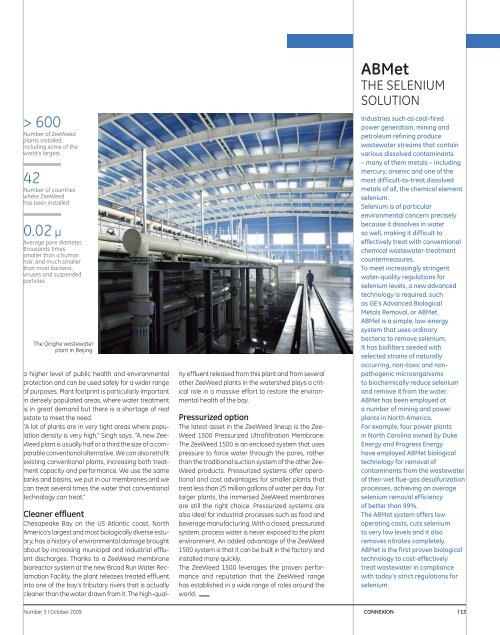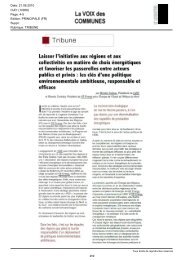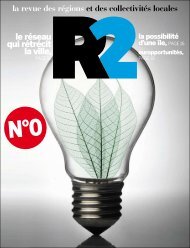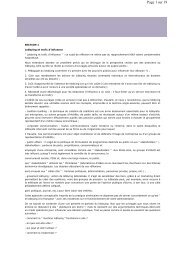GE ENErGy - Frank Farnel
GE ENErGy - Frank Farnel
GE ENErGy - Frank Farnel
You also want an ePaper? Increase the reach of your titles
YUMPU automatically turns print PDFs into web optimized ePapers that Google loves.
600<br />
Number of ZeeWeed<br />
plants installed,<br />
including some of the<br />
world’s largest<br />
42<br />
Number of countries<br />
where ZeeWeed<br />
has been installed<br />
0.02 µ<br />
Average pore diameter,<br />
thousands times<br />
smaller than a human<br />
hair, and much smaller<br />
than most bacteria,<br />
viruses and suspended<br />
particles<br />
The qinghe wastewater<br />
plant in beijing.<br />
a higher level of public health and environmental<br />
protection and can be used safely for a wider range<br />
of purposes. Plant footprint is particularly important<br />
in densely populated areas, where water treatment<br />
is in great demand but there is a shortage of real<br />
estate to meet the need.<br />
“A lot of plants are in very tight areas where population<br />
density is very high,” Singh says. “A new Zee-<br />
Weed plant is usually half or a third the size of a comparable<br />
conventional alternative. We can also retrofit<br />
existing conventional plants, increasing both treatment<br />
capacity and performance. We use the same<br />
tanks and basins, we put in our membranes and we<br />
can treat several times the water that conventional<br />
technology can treat.”<br />
Cleaner effluent<br />
Chesapeake bay on the US Atlantic coast, North<br />
America’s largest and most biologically diverse estuary,<br />
has a history of environmental damage brought<br />
about by increasing municipal and industrial effluent<br />
discharges. Thanks to a ZeeWeed membrane<br />
bioreactor system at the new broad run Water reclamation<br />
Facility, the plant releases treated effluent<br />
into one of the bay’s tributary rivers that is actually<br />
cleaner than the water drawn from it. The high-qual-<br />
ity effluent released from this plant and from several<br />
other ZeeWeed plants in the watershed plays a critical<br />
role in a massive effort to restore the environmental<br />
health of the bay.<br />
pressurized option<br />
The latest asset in the ZeeWeed lineup is the Zee-<br />
Weed 1500 Pressurized Ultrafiltration Membrane.<br />
The ZeeWeed 1500 is an enclosed system that uses<br />
pressure to force water through the pores, rather<br />
than the traditional suction system of the other Zee-<br />
Weed products. Pressurized systems offer operational<br />
and cost advantages for smaller plants that<br />
treat less than 25 million gallons of water per day. For<br />
larger plants, the immersed ZeeWeed membranes<br />
are still the right choice. Pressurized systems are<br />
also ideal for industrial processes such as food and<br />
beverage manufacturing. With a closed, pressurized<br />
system, process water is never exposed to the plant<br />
environment. An added advantage of the ZeeWeed<br />
1500 system is that it can be built in the factory and<br />
installed more quickly.<br />
The ZeeWeed 1500 leverages the proven performance<br />
and reputation that the ZeeWeed range<br />
has established in a wide range of roles around the<br />
world.<br />
aBMet<br />
THE SELENIUM<br />
SOLUTION<br />
industries such as coal-fired<br />
power generation, mining and<br />
petroleum refining produce<br />
wastewater streams that contain<br />
various dissolved contaminants<br />
– many of them metals – including<br />
mercury, arsenic and one of the<br />
most difficult-to-treat dissolved<br />
metals of all, the chemical element<br />
selenium.<br />
Selenium is of particular<br />
environmental concern precisely<br />
because it dissolves in water<br />
so well, making it difficult to<br />
effectively treat with conventional<br />
chemical wastewater-treatment<br />
countermeasures.<br />
To meet increasingly stringent<br />
water-quality regulations for<br />
selenium levels, a new advanced<br />
technology is required, such<br />
as ge’s advanced Biological<br />
Metals removal, or aBMet.<br />
aBMet is a simple, low-energy<br />
system that uses ordinary<br />
bacteria to remove selenium.<br />
it has biofilters seeded with<br />
selected strains of naturally<br />
occurring, non-toxic and nonpathogenic<br />
microorganisms<br />
to biochemically reduce selenium<br />
and remove it from the water.<br />
aBMet has been employed at<br />
a number of mining and power<br />
plants in north america.<br />
for example, four power plants<br />
in north Carolina owned by Duke<br />
energy and progress energy<br />
have employed aBMet biological<br />
technology for removal of<br />
contaminants from the wastewater<br />
of their wet flue-gas desulfurization<br />
processes, achieving an average<br />
selenium removal efficiency<br />
of better than 99%.<br />
The aBMet system offers low<br />
operating costs, cuts selenium<br />
to very low levels and it also<br />
removes nitrates completely.<br />
aBMet is the first proven biological<br />
technology to cost-effectively<br />
treat wastewater in compliance<br />
with today’s strict regulations for<br />
selenium.<br />
Number 3 l October 2009 CONNEXION l 13







